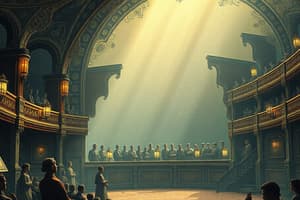Podcast
Questions and Answers
What defines modern theater according to its historical context?
What defines modern theater according to its historical context?
- It prioritizes classical themes and cultural heritage.
- It strictly follows traditional performance techniques.
- It focuses on grand narratives and historical events.
- It emerged in the late 19th to 20th century emphasizing innovation. (correct)
Which movement in modern theater emphasized visual form and emotional subjectivity?
Which movement in modern theater emphasized visual form and emotional subjectivity?
- Expressionism (correct)
- Futurism
- Naturalism
- Dadaism
Who are some notable playwrights associated with the rise of naturalism and realism in the 1870s?
Who are some notable playwrights associated with the rise of naturalism and realism in the 1870s?
- Henrik Ibsen and Samuel Beckett
- Henrik Ibsen and Anton Chekhov (correct)
- Samuel Beckett and Anton Chekhov
- W.S. Rendra and Samuel Beckett
What was a characteristic of the Absurd Theater during the 1940s-1950s?
What was a characteristic of the Absurd Theater during the 1940s-1950s?
What aspect differentiates modern theater from traditional performances in Indonesia?
What aspect differentiates modern theater from traditional performances in Indonesia?
Flashcards are hidden until you start studying
Study Notes
Sejarah Teater Modern
-
Definisi Teater Modern: Teater yang muncul pada akhir abad ke-19 hingga abad ke-20, mengedepankan inovasi dalam bentuk, tema, dan teknik pertunjukan.
-
Akar Teater Modern:
- Terpengaruh oleh perubahan sosial, politik, dan teknologi.
- Memperkenalkan ide-ide baru dalam narasi dan karakter.
-
Perkembangan Awal:
- Tahun 1870-an: Munculnya drama naturalis dan realis, dipelopori oleh penulis seperti Henrik Ibsen dan Anton Chekhov.
- Fokus pada kehidupan sehari-hari dan isu sosial.
-
Ekspresionisme (1900-an):
- Mencerminkan emosi dan pengalaman subjektif.
- Menekankan bentuk visual dan simbolis, menggugah perasaan penonton.
-
Futurisme dan Dadaisme (awal 1900-an):
- Futurisme: Merayakan modernitas dan teknologi.
- Dadaisme: Menolak norma-norma seni dan mempertanyakan nilai estetika.
-
Teater Absurd (1940-an-1950-an):
- Mencerminkan pandangan pesimistis tentang kehidupan.
- Karya-karya Samuel Beckett, seperti "Waiting for Godot."
-
Perkembangan di Indonesia:
- Teater modern Indonesia dimulai pada awal abad ke-20.
- Pengaruh teater Barat dan lokal, seperti Sandiwara dan Wayang.
- Tokoh seperti W.S. Rendra mempopulerkan teater modern dengan tema sosial dan politik.
-
Ciri-Ciri Teater Modern:
- Narasi yang lebih kompleks dan non-linear.
- Eksplorasi gaya akting dan penyajian yang inovatif.
- Penggunaan multimedia dan teknologi dalam pertunjukan.
-
Pengaruh dan Legacy:
- Teater modern telah mempengaruhi film, televisi, dan bentuk seni pertunjukan lainnya.
- Mendorong keberagaman dalam ekspresi artistik dan penanganan isu-isu kontemporer.
Definition of Modern Theater
- Emerged in the late 19th to 20th century, emphasizing innovation in form, themes, and performance techniques.
Roots of Modern Theater
- Influenced by social, political, and technological changes.
- Introduced new ideas in narrative structure and character development.
Early Development
- 1870s marked the rise of naturalistic and realistic drama.
- Pioneered by playwrights like Henrik Ibsen and Anton Chekhov.
- Focused on everyday life and social issues.
Expressionism (1900s)
- Reflected emotions and subjective experiences.
- Emphasized visual and symbolic forms to evoke audience feelings.
Futurism and Dadaism (Early 1900s)
- Futurism celebrated modernity and technology.
- Dadaism rejected traditional artistic norms and questioned aesthetic values.
Theater of the Absurd (1940s-1950s)
- Presented a pessimistic view of life.
- Notable works include Samuel Beckett's "Waiting for Godot."
Development in Indonesia
- Indonesian modern theater began in the early 20th century.
- Influenced by both Western theater and local forms like Sandiwara and Wayang.
- Key figures, such as W.S. Rendra, popularized modern theater with social and political themes.
Characteristics of Modern Theater
- Complex and non-linear narratives.
- Innovative acting styles and presentation methods.
- Integration of multimedia and technology in performances.
Influence and Legacy
- Modern theater has impacted film, television, and other performance arts.
- Encouraged diversity in artistic expression and tackled contemporary issues.
Studying That Suits You
Use AI to generate personalized quizzes and flashcards to suit your learning preferences.



